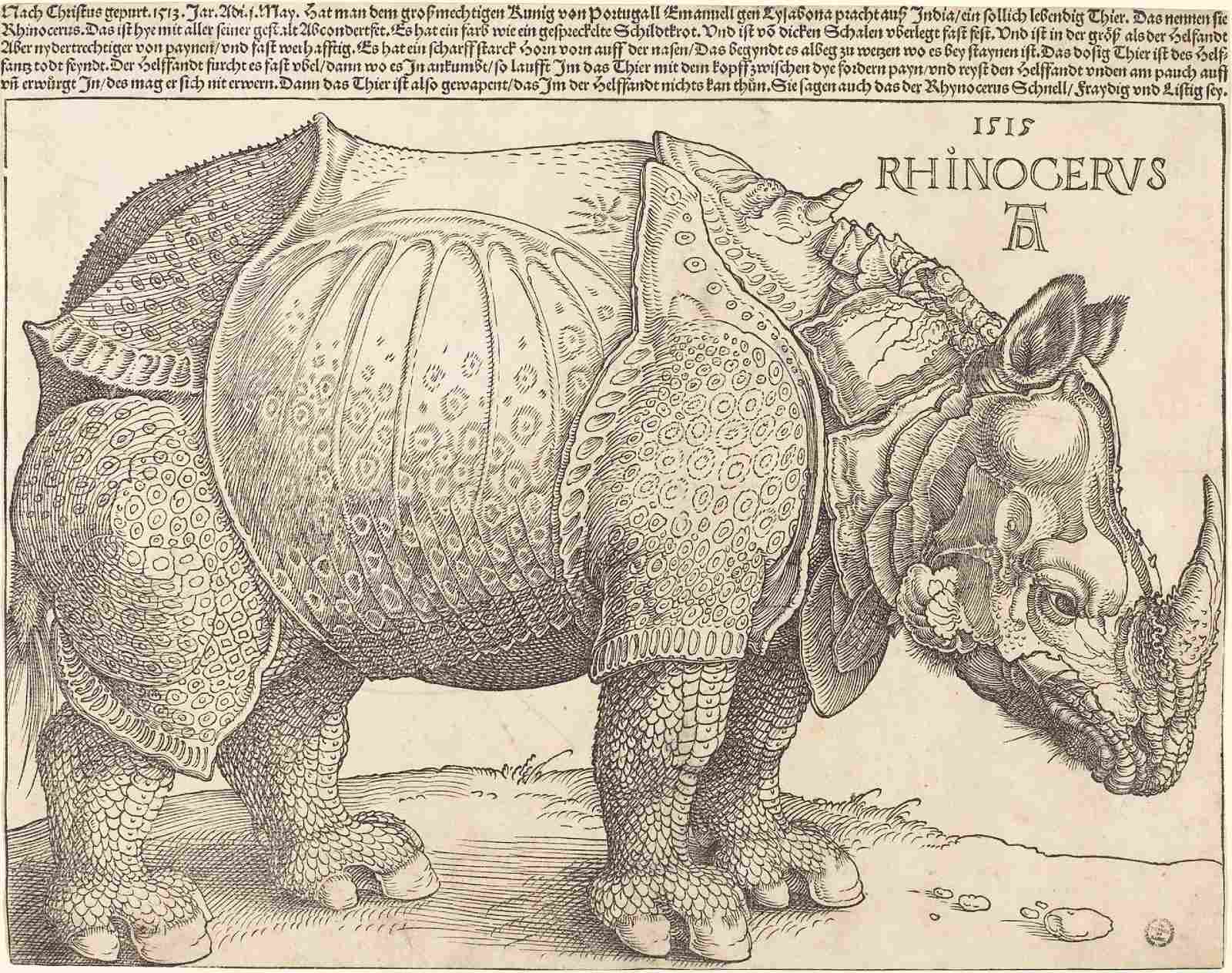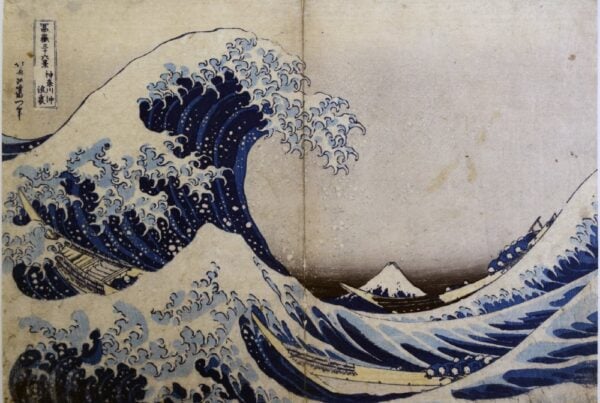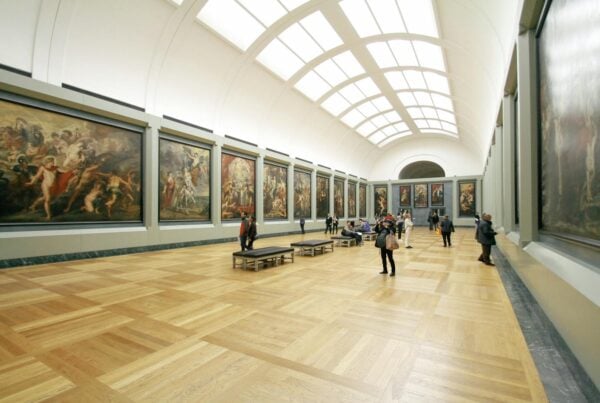Albrecht Dürer, a towering figure in the world of art, left an indelible mark with his masterful woodcuts. Born in Nuremberg, Germany, in 1471, Dürer’s work is renowned for its intricate detail and dynamic tonal range, especially evident in his famous “Apocalypse” series. His ability to convey complex religious narratives through woodcut prints set new standards and fascinated audiences across Europe.
Dürer’s “Apocalypse” series, created in the late 15th to early 16th century, remains one of his most celebrated works. Each piece in this series demonstrates his skill in combining dramatic storylines with meticulous attention to detail, bringing biblical tales to life in ways previously unseen. These works exemplify his deep integration of symbolism, reflecting the religious fervour and artistic innovation of the Renaissance period.
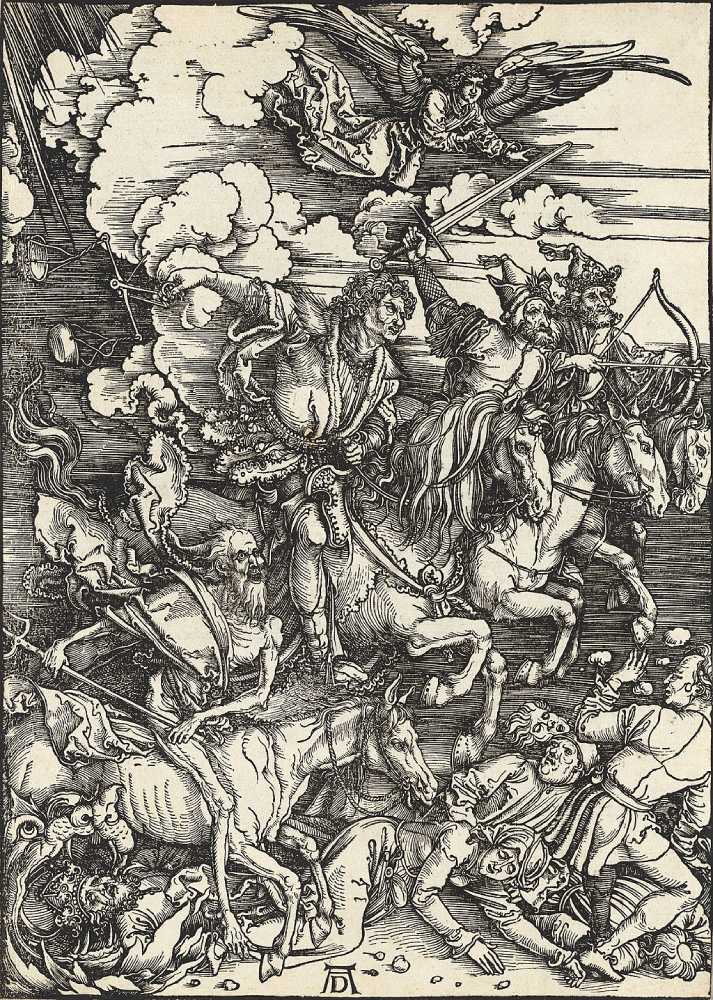
Albrecht Dürer – The Four Horsemen of the Apocalypse (1498)
Today, Dürer’s influence is still felt in the world of art. His pioneering techniques in woodcutting and his bold storytelling continue to inspire artists and captivate art enthusiasts. Those looking to dive deeper into the history of Renaissance art will find his work a fascinating gateway into understanding the profound impact of printmaking on artistic expression.
Table of Contents
Key Takeaways
- Albrecht Dürer was a master of woodcut art, especially known for the “Apocalypse” series.
- His works highlight the intricate detail and rich symbolism of the Renaissance era.
- Dürer’s techniques and storytelling continue to influence and inspire modern art.
Life and Career of Albrecht Dürer
Albrecht Dürer, a prominent figure of the German Renaissance, was renowned for his masterful woodcuts and engravings. His work was greatly influenced by his early years in Nuremberg, significant periods of study and travel, and his later career, which left a lasting legacy.
Early Years in Nuremberg
Albrecht Dürer was born on 21 May 1471 in Nuremberg, Germany. The city was a thriving centre of art and commerce during this time. His father, Albrecht Dürer the Elder, was a goldsmith, and it was in his workshop that young Dürer first learned about art and craftsmanship.
Dürer’s artistic journey began with an apprenticeship under the painter Michael Wolgemut. This apprenticeship provided him with foundational skills in drawing, painting, and engraving. It was during these early years that Dürer developed a keen eye for detail and a deep appreciation for religious and mythological themes, which would later become central to his work.
Significant Periods and Influences
After completing his apprenticeship, Dürer embarked on a series of travels that expanded his artistic horizons. His first major journey was to Italy, where he was exposed to the Renaissance masters. The influence of artists such as Leonardo da Vinci and Andrea Mantegna had a profound impact on his style.
Dürer’s time in Italy introduced him to the techniques of perspective and proportion, which he incorporated into his own work. His famous series, the “Apocalypse”, showcased intricate details and a rich tonal range, reflecting his mastery of woodcut techniques.
Beyond Italy, his travels within Germany and the Low Countries also exposed him to various artistic movements and ideas. He absorbed these influences, enriching his own artistic practice and contributing to his reputation as a pioneering figure in German art.
Dürer’s Later Years and Legacy
In the later stages of his life, Dürer continued to produce significant works that solidified his legacy. His detailed engravings, religious prints, and portraits reflected both his technical precision and his humanistic concerns. He also engaged in theoretical writings about art, further showcasing his comprehensive understanding of the craft.
Living in Nuremberg until his death in 1528, Dürer left behind a vast collection that has been celebrated for generations. His influence extended beyond his lifetime, impacting both the Renaissance and future artistic movements. His works remain pivotal in the study of art history, demonstrating the importance of meticulous technique paired with imaginative vision.
Dürer’s Woodcut Techniques
Albrecht Dürer was renowned for the intricate detail and depth he brought to his woodcuts. His work not only showcased technical skill with materials but also marked significant innovations in printmaking.
Materials and Methods
Dürer primarily used woodcut as his medium, a method that involved carving images into wood blocks. He often selected hardwood, which provided durability and allowed for finer detail. The designs were meticulously cut, with raised areas forming intricate patterns.
He printed on laid paper, a type commonly used in his time, known for its ribbed texture and durability. The use of this paper helped in defining lines and capturing details precisely. Dürer’s works often featured watermarks, which served as a mark of authenticity and quality. These watermarks made it easier to identify original pieces, distinguishing them from copies and forgeries.
Innovation in Printmaking
Dürer’s woodcuts stood out for their unprecedented detail. He mastered the interplay of light and shadow, creating tonal ranges that few had achieved before. His famous series, the “Apocalypse”, showed these innovations clearly.
The composition of his prints often exhibited depth and perspective, not commonly found in previous woodcuts. By enhancing visual narrative through woodcut, Dürer elevated the form beyond mere illustration. His work inspired future artists and expanded possibilities within printmaking, setting a high standard for technical and artistic excellence.
Iconic Series and Standalone Works
Albrecht Dürer’s work is renowned for its complexity and depth. His series like “The Apocalypse” and “Life of the Virgin” highlight his mastery in woodcutting. Standalone works such as “Saint Jerome in His Study” also reflect his unique approach to detail and tone.
The Apocalypse Series
“The Apocalypse” series, completed in 1498, is among Dürer’s most famous woodcut sequences. It comprises 15 prints illustrating scenes from the Book of Revelation. These prints were groundbreaking for their time due to their intricate detail and dramatic expression.
Dürer’s use of bold lines and meticulous designs brought scriptural scenes to life. His ability to convey movement and emotion in “The Four Horsemen of the Apocalypse” left a lasting impact on European art. This series cemented Dürer’s reputation as a leading artist of the German Renaissance.
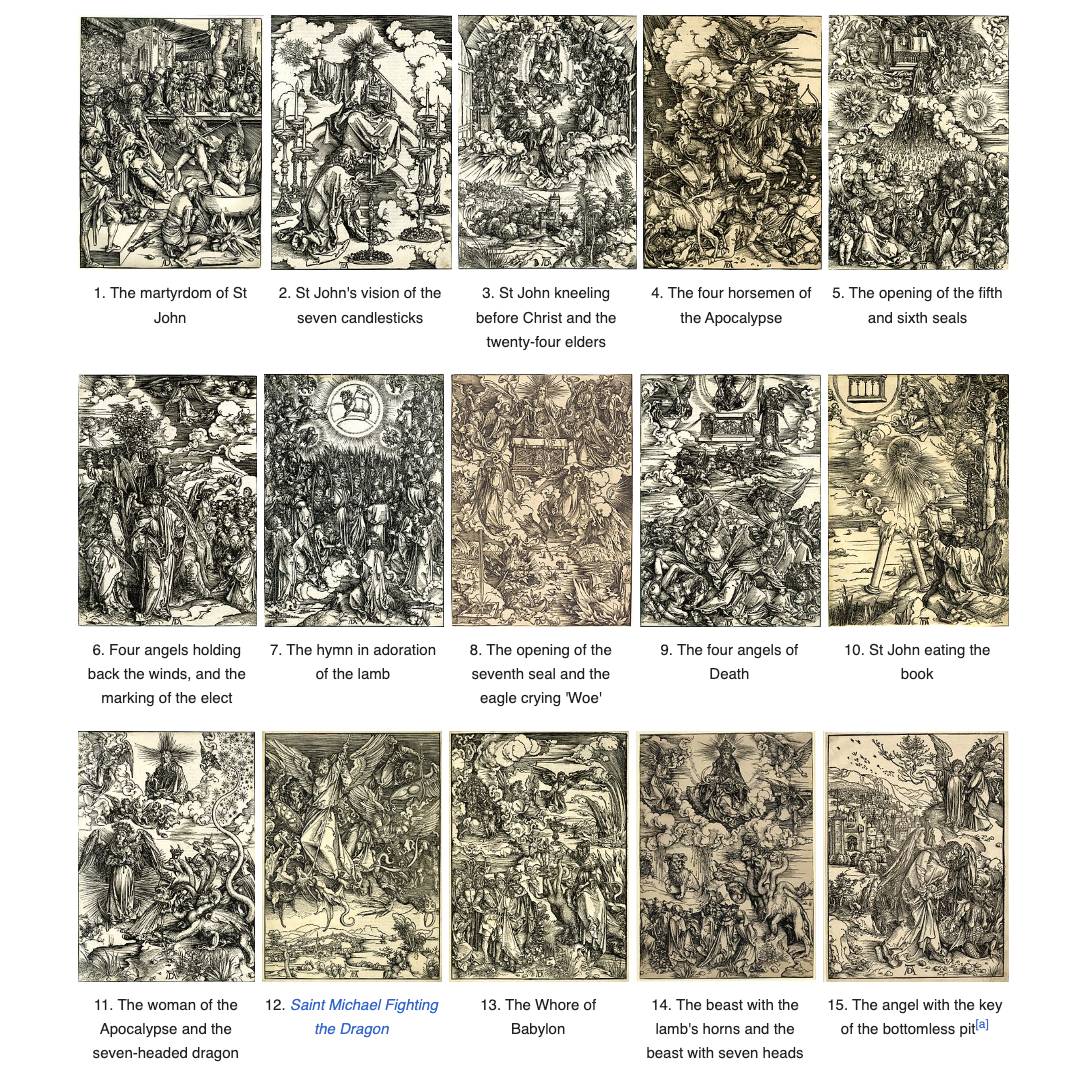
Albrecht Dürer – Apocalypse Series Wikipedia
Life of the Virgin
Dürer’s “Life of the Virgin” series included a collection of 19 woodcuts completed by 1511. These works tell the story of the Virgin Mary’s life, capturing key moments with clarity and grace. The prints are notable for their narrative structure and detailed background scenes.
The series includes the “Adoration of the Shepherds,” a piece that shows Dürer’s skill in blending human emotion with sacred themes. His ability to incorporate architectural details adds depth to the scenes. This series reflects his skill in weaving religious devotion with artistic innovation.
Small Passion and Other Works
The “Small Passion” series, published in 1511, includes 36 woodcuts that depict the Passion of Christ. In contrast to larger prints, these images are smaller yet rich in detail and emotional intensity. Each woodcut captures pivotal events with precision, like the “Crucifixion.”
Other standalone works, like “Saint Jerome in His Study” and “Adam and Eve,” demonstrate Dürer’s diverse skill set. “Saint Jerome” is a masterful engraving showing a serene interior scene, whereas “Adam and Eve” showcases his expertise in anatomy and natural detail. Each work adds to Dürer’s legacy as a pioneer in art.
Religious Themes and Symbolism
Albrecht Dürer’s work often depicted deep religious themes, brought to life through intricate woodcuts. He illustrated complex scenes of saints, apocalyptic visions, and narratives of the Nativity with extraordinary attention to detail and symbolism.
Saints and Martyrdom
Dürer frequently highlighted the lives of saints, presenting themes of sacrifice and faith. His works often depicted well-known saints, offering visual stories of their martyrdom. These portrayals were rich in expression and subtle details, reflecting the emotional depth and spiritual struggles of these figures.
Christ Crowned with Thorns is a notable example where Dürer focused on the intense suffering of Christ, capturing both physical and emotional pain. The use of light and shadow in these depictions added to the dramatic intensity, engaging viewers on a deeper spiritual level.
Apocalyptic Imagery
The Apocalypse series by Dürer remains a landmark in religious art for its vivid portrayal of end-times. He translated the Book of Revelation into a sequence of dramatic visuals, including the Beast with Two Horns Like a Lamb.
These images were filled with symbolic details that conveyed the chaos and fear of the apocalypse, as well as the hope of redemption. Angels often appeared in these scenes, either as bringers of messages or as symbols of divine intervention, emphasizing the clash between good and evil.
Narratives of the Nativity
Dürer’s woodcuts of the Nativity scenes are renowned for their intricate detail and emotive power. They depict the birth of Christ with a focus on human emotion and divine significance.
The Presentation of the Virgin in the Temple showcased the early life of Mary, laying the groundwork for the coming of Christ. Through these narratives, Dürer portrayed not only historical events but also the spiritual essence behind them.
These works aimed to inspire devotion and reflect on the divine mysteries surrounding the Nativity. His portrayals were not just illustrations but immersive experiences for the viewers, inviting them to meditate on profound religious insights.
Impact on Renaissance Art
Albrecht Dürer had a significant influence on the art world, particularly during the Renaissance. His innovative use of woodcuts and engravings set new standards in artistic detail and tonal range.
Influence on Contemporary Artists
During the Renaissance, Dürer’s work in woodcuts and engravings became immensely influential among his contemporaries. Artists admired his ability to combine intricate detail with expressive power. His Apocalypse series from 1498, with its dynamic imagery based on the Book of Revelation, inspired many artists to explore similar themes of cosmic upheaval. Dürer’s techniques in creating rich tonal contrasts offered a new way to depict depth and emotion, which was groundbreaking for that era.
His ability to capture the human form with precise detail also resonated with artists across Europe, encouraging them to adopt similar methods in their work. The widespread distribution of his prints allowed his techniques to reach far and wide, leaving a lasting impact on the art community. His prints even made their way to Spaightwood Galleries, showcasing the Complete Set in Excellent Condition.
Dürer’s Contribution to Northern Renaissance
Dürer played a crucial role in the Northern Renaissance by elevating the status of printmaking to an art form of equal importance as painting. His works demonstrated that engravings could be more than just illustrative; they became a vehicle for powerful artistic expression. His piece, Melencolia I, is a prime example of his mastery in engraving, showing extraordinary attention to detail.
The 1497-98 period was particularly significant for Dürer as he developed techniques that would define the Northern Renaissance style. By bridging the gap between the artistic advancements of Italy and the traditional craftsmanship of the north, Dürer enriched the visual language of the era. His efforts ensured that Northern Renaissance art was not overshadowed by its Southern counterpart.
Frequently Asked Questions
Albrecht Dürer played a crucial role in advancing woodcut art, contributing significantly to the Northern Renaissance. His mastery of intricate relief prints is evident in the “Apocalypse” series, showcasing exceptional detail and tonal variation. His work elevated the status of artists in society by demonstrating artistic skill and innovative techniques.
How did Albrecht Dürer contribute to the development of woodcut art?
Albrecht Dürer revolutionised woodcut art by introducing a level of detail and expression previously unseen. His innovative techniques, such as precise line work and intricate designs, pushed the boundaries of what woodcuts could depict. This advancement not only enhanced the artistic quality but also broadened the use of woodcuts for both art and communication.
What techniques did Albrecht Dürer employ to achieve detailed relief prints in his Apocalypse series?
In the “Apocalypse” series, Dürer utilised exceptional line work to create deep contrasts and rich textures in the prints. He achieved depth and detail through careful carving, allowing for varied tones. His systematic approach to layering lines and his attention to detail set these works apart in the realm of printmaking.
Why is Albrecht Dürer considered a pivotal figure in the Northern Renaissance?
Dürer’s work exemplifies the Northern Renaissance’s blend of artistic innovation and cultural revival. He integrated Northern European artistic traditions with innovations from the Italian Renaissance. His broad artistic range, including religious themes and realistic portraits, helped usher in new levels of depth and realism in Northern European art.
What impact did Albrecht Dürer’s work have on the perception of artists in society?
Albrecht Dürer elevated the status of artists within society by showcasing the intellectual and creative capabilities of art. His successful portrayal as a learned artist altered public perception, positioning art as an esteemed profession. His self-portraits and published works demonstrated the artist’s role as both creator and thinker, influencing society’s appreciation for artistic contributions.
How does Albrecht Dürer’s most renowned piece reflect his artistic philosophy and technical skill?
Dürer’s “Melencolia I” captures his philosophical exploration of human creativity and ambition. The piece demonstrates his meticulous attention to detail and mastery of engraving techniques. The complex symbolism and intricate design highlight Dürer’s commitment to exploring deep themes through technically demanding and visually compelling compositions.
What distinguishes Albrecht Dürer’s artistic style from that of his contemporaries?
Dürer’s style blends Northern intricacy with Italian influences and is known for its precision and detail. He incorporated mathematical perspective and proportion in his compositions, setting his work apart. His works are also unique because he combines technical precision with emotional depth.




